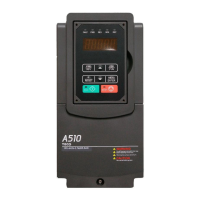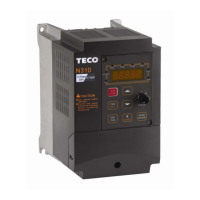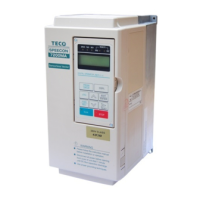4-67
【0】: PID Function disabled
【1】: FWD Characteristic. (Deviation is D-controlled)
【2】: FWD Characteristic. (Feedback is D-controlled)
【3】: REV Characteristic. (Deviation is D-controlled)
【4】: REV Characteristic. (Feedback is D-controlled)
【5】:FWD Characteristic. (Frequency Command +Deviation D Control)
【6】:FWD Characteristic. (Frequency Command + Feedback D Control)
【7】:Reverse Characteristic. (Frequency Command + Deviation D Control)
【8】:Reverse Characteristic. (Frequency Command + Feedback D Control)
10-03 =【1】: Positive characteristic with PID derivative control of setpoint/target value minus feedback value
set by parameter 10-07. If the PID error is positive, the output frequency increases and decreases when PID
error is negative.
10-03 =【2】: Positive characteristic with PID derivative control of feedback value set by parameter 10-07. If
the PID error is positive, the output frequency increases and decreases when PID error is negative.
10-03 =【3】: Negative characteristic with PID derivative control of setpoint/target value minus feedback value
set by parameter 10-07. If the PID error is positive, the output frequency decreases and increases when PID
error is negative.
10-03 =【4】: Negative characteristic with PID derivative control of feedback value set by parameter 10-07. If
the PID error is positive, the output frequency decreases and increases when PID error is negative.
10-03 =【5~8】: Output frequency = PID output frequency + frequency command (10-03 =【1~4】.
Proportional Gain Control: The error signal (deviation) between the input command (set value) and the actual
control value (feedback). This error signal or deviation is amplified by the proportional gain (P) to control the offset
between the set value and the feedback value.
Integral Time Control: The output of this control is the integral of the error signal (difference between set value
and feedback value) and is used to minimize the offset signal that is left over from the gain control. When the
integral time (I) is increased, the system response becomes slower.
Derivative Time Control: This control is the inverse from integral control and tries to guess the behavior of the
error signal by multiplying the error with the differential time. The result is added to the PID input. Derivative
control slows down the PID controller response and may reduce system oscillation. Note: Most applications that
use PID control (fan and pump) do not require derivative control.
Feedback Gain coefficient
10-04 is the calibration gain. Deviation = set point – (feedback signal×10-04)
10-05: Proportion gain for P control.
10-06: Integration time for I control

